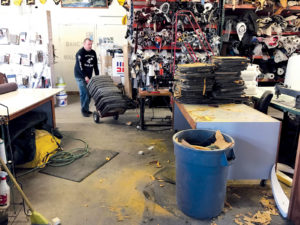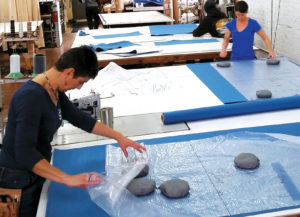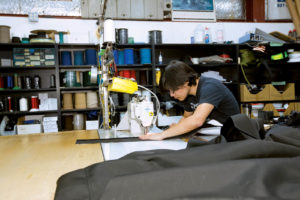It’s a fairly safe bet that not many fabricators started their operations because they wanted to work on spreadsheets. But like it or not, when you hang out a shingle, only part of your work will be designing a custom awning or reupholstering seats on a pontoon boat. Figuring out how to charge for those jobs accurately is just as critical to your success.
The importance of job costing may seem obvious—you’re in this business to turn a profit, after all—but it’s still something that many fabricators can struggle with. The burden of accounting is only part of it.
To begin with, a busy fabricator may run into difficulty coming up with the minutes and hours needed for successful job costing.
Sharpen your axe
Justin Jones, owner of SewLong Custom Covers in Salt Lake City, Utah, puts it this way, paraphrasing Abraham Lincoln: “As a business owner, I’m so busy chopping down trees it’s hard to find the time to sharpen my axe.”

“When time is at a premium, it’s easy to become stagnant,” Jones says, which can lead to ignoring important factors needed for accurate job estimates. “Things happen, like not keeping up with price increases. The cost of fabrics goes up 2 or 3 or 5 percent every year. Everything increases, but we sometimes don’t raise our prices, just because we don’t take the time to.”
Keeping tabs on the cost of materials is just a start. Many fabricators find they benefit from a defined process. While the process you use may be unique to your needs, Chandler Clark, owner of Signature CanvasMakers, a full-service marine canvas shop in Hampton, Va., since 2005, offers some tips.
Clark says he starts each job by getting as much information as possible up front from the customer. That includes the requirement that he have a look at the boat he’s being asked to work on—or at least see a photo, for less complex projects—before he’ll provide a quote.
He also finds it a good practice to give a firm price quote, not just an estimate. “Unless the customer changes the scope of work or we agree to upgrades or changes after they have accepted the initial quote, the price does not change,” he says. “That means it is even more important that we have all of the information at our disposal to ensure an accurate price is provided—fabrics and materials that will be used and the options, the material quantities needed, the amount of labor including patterning, digitizing/cutting, fabricating and installation, and any add-on options.”

As Clark points out, the cost of materials is only a portion of the formula used to establish a price for work being done. The rest of it—labor and overhead, for example—is just as important.
“For a long time, there was no real rhyme or reason to our job costing process,” Jones says. “We charged what we did simply because we heard what our competition was doing or what we felt was acceptable. One of the things we didn’t do a good job with was accounting for overhead.”
But that’s changed at SewLong; he says: “We’ve been working on making sure our hourly rate accounts for overhead, trying to do a better job of evaluating what is true overhead versus what is the cost of the job.”
Account for true costs
Steven Malone, founder and principal consultant at IronClad CFO in Salt Lake City, has worked with SewLong and other companies to establish or improve their job costing processes. He says he sees a lot of small businesses that don’t understand what it takes to do the work.
“When they go to do their estimates, they’re not accounting for everything, so they end up shorting themselves on what they should be charging,” Malone says.
“It’s critical to understand what your true costs are,” he adds. “With labor, for example, it’s not just the hourly rate you are paying someone, but there are taxes on top of that, and insurance. If you’re paying an employee $60,000 a year, you need to know the true burden is actually closer to $72,000.”
Another mistake often made in job costing is equating margin and markup, according to Malone. If the cost of your product is $100, and you require a 20 percent margin, you can’t just mark it
up 20 percent, Malone adds. That results in a price of $120, which is a margin of only 16.66 percent. Instead, to hit the required margin, you need to mark the price up to $125.
“I know that can be a hard concept to understand,” Malone acknowledges. “But it’s a problem if you think you’re making 20 percent and you’re really only making 16 percent. When you start talking bigger projects, that adds up pretty darn quick.
“If you wonder why you’re always out of cash, it’s because you’re leaving cash on the table,” he says.
Then there are the unexpected developments during a project that can throw off any cost estimate. But according to Ryan Chism, vice president of The Chism Company Inc., a manufacturer of architectural/industrial shade and protective products in San Antonio, Texas, the “unexpected” can often actually be predicted—and taken into consideration in the job cost.
“We do a lot of work in general contractor–type of construction, where things go wrong despite your best efforts,” Chism says. “A construction site can be crazy; there’s rescheduling or rework that is nobody’s fault but it happens, and you lose a day. We complained about it to our accountant, and he said, ‘It’s a cost of doing business; you need to put it in overhead.’ We went back over the years and tracked what our exposure was, and put that in as a factor. It’s a fee for service and we end up using it all the time—and it sort of takes the pressure off.”
Ask the right questions
“We have learned to ask questions and use wording that helps us avoid absorbing the cost of the extra time incurred,” Clark notes. “For example, we have to make sure we have access to the boat when we need it. If we have quoted a bimini at a standard price and the customer has the boat apart, under a cover, or would like us to attach another piece to it, like an old enclosure, that adds time to the job that must be accounted for.”

When estimating, you need a clear set of assumptions, Malone says, “and you need to review those assumptions with the client. There may be things the client assumes is part of the quote that aren’t. Make sure everyone is on the same page. When you’re not, and something happens, you can end up with a real customer service problem.”
Many fabricators agree that the larger the job, the more unknowns can come into play.
“We work quite a bit with military and government contractors on large-scale and prototype projects, often without initial access to the vessel,” Clark says. “It’s difficult to determine the challenges that could affect the overall project just from drawings. There are so many unknowns early on, so we have to factor in a contingency plan.”
Even smaller jobs can present issues. “It might happen when we’re doing replacement fabric work on very old properties,” Chism says. “The job itself may not take much time, but you might end up having to take a half-dozen trips to the site, measuring different things, and that’s really hard. The salesperson managing that job is going to use up a lot of time that can’t be used for selling. It’s an opportunity cost, and you have to figure out a way to account for that.”
Use the right tools
Just as methods for determining a job cost vary widely among fabricators, so does the technology used when doing estimates.
On one side of the coin is Larry Schneider, owner of Homestyle Awning & Upholstery in downtown Milwaukee, Wis. Schneider, who has been doing upholstery work since 1972 and has owned his own shop since 1983, still does things the old-fashioned way.
“I’ve always been a pretty low-tech guy. I still do handwritten estimates and receipts; I’m kind of stuck in the past that way,” Schneider says. Given that he keeps six employees busy, it seems to work for him.
Then there’s Jones at SewLong, who has built his own job costing software based on a FileMaker Platform. “It helps us create estimates, but once we get the job, it becomes a project management tool as well,” he says. Jones’s program automatically updates the cost of materials, for example, giving the clearest picture of what a job will actually cost.
Mario Nowogrodzki, CPA/CITP, founder and principal at Mendelson Consulting in Pembroke Pines, Fla., which specializes in QuickBooks® and technology consulting services, says that many people assume QuickBooks is the most common software used for accounting. He says it’s not.
“That distinction belongs to Microsoft® Excel®, but even though it’s used for accounting, it’s not really accounting software,” Nowogrodzki says.
“One of the keys in any business with job costing is looking at reports,” Nowogrodzki says, and he believes an Excel spreadsheet just doesn’t show enough. “Something like QuickBooks is so much better for showing the actual versus estimate on a per job or project basis. You’ll see where you made or lost money or where you didn’t make enough. To make the right business decisions, it’s crucial to use the right tools, and it is not difficult to do so.”
Adopting new technology can be hard, Nowogrodzki admits, and Homestyle’s Schneider agrees. “I’m the old dog, hard to teach new tricks,” Schneider says, but even he is amenable to change. “My wife is going to retire soon from her job,” he says, “and her plan is to come in and help me get this thing computerized.”
The advantage, according to Schneider, will be efficiency and organization. “We might be able to get out of town for a week once in a while,” he says.
Jeff Moravec is a freelance writer from Minneapolis, Minn.
Ryan Chism, vice president of The Chism Company Inc., a manufacturer of architectural/industrial shade and protective products in San Antonio, Texas, says one of the most difficult aspects of job costing is when a potential client “has an idea but no strict specifications.”
Chism says he avoids wasting both his time and the customer’s by “being open up front. You have to ask: What do you think you should be spending on this? What do you think this should cost?
“You want to get a sense if they have a budget in mind, first of all, to see if it’s realistic,” he explains. “You don’t want to spend hours putting a proposal together for someone who then says, ‘Whoa, that’s way out of budget.’”
Chism says experienced fabricators will generally know within a margin of about 10 percent what a job is going to cost, so if what his potential client wants seems like it is going to be more than their budget, he wants to be ready with alternatives.
“I try to think of a couple of options that make sense to me for the money,” Chism says. “I’ll write up a summary of those options and they can discuss with their group what’s going on and then see where they are. Then we can work toward something more specific.”
Cost-based pricing (CBP) may be the most common and easiest way for fabricators to come up with job cost estimates, but it’s not the only way, says Steven Malone, founder and principal consultant at IronClad CFO in Salt Lake City, Utah.
Using cost-based pricing, an estimate accounts for “above the line” costs (labor, materials and miscellaneous costs such as travel) and “below the line” costs such as indirect expenses and operating expenses (overhead). Such a system, according to Malone, accurately identifies how much it costs to produce a job or service.
But, Malone says, cost-based pricing should not be the only deciding factor in pricing. “Look at your competition and their product pricing, and look at your customer,” he explains. “Just because your CBP analysis says you can sell something for $500, if the customer is willing to pay $750, then charge $750.”
 TEXTILES.ORG
TEXTILES.ORG



